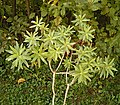Tree Spurge
| Tree Spurge | ||||||||||||
|---|---|---|---|---|---|---|---|---|---|---|---|---|

Tree Spurge ( Euphorbia dendroides ) in Mallorca |
||||||||||||
| Systematics | ||||||||||||
|
||||||||||||
| Scientific name | ||||||||||||
| Euphorbia dendroides | ||||||||||||
| L. |
The tree spurge ( Euphorbia dendroides ) is a plant species in the genus spurge ( Euphorbia ) from the family of the spurge family (Euphorbiaceae).
The German and the botanical name describe the tree-shaped growth form of the species. The trunk typical of a tree is only sometimes developed.
description
The tree milkweed is a densely branched shrub or tree with a hemispherical crown that reaches heights of growth of up to 2 m. The mostly dichotomous branches are weakly succulent and soon become lignified. At their ends they have lanceolate, up to 6.5 × 0.8 cm long, sessile leaves which, after their wilting, leave the branches covered with leaf scars bare.
The inflorescences are sham umbels with five to eight rays, which usually branch again in bifurcated form. The paired bracts standing close to the cyathia are egg-shaped, about 10 × 15 mm in size and yellow-green in color. The four nectar glands of the cyathia are almost circular and have two short horns on the outside. They are initially yellow and turn red over time. The seeds that arise from the deeply lobed fruits are egg-shaped, up to 3 mm long and have a caruncula .
The number of chromosomes is 2n = 18.
distribution
The tree spurge occurs in the Mediterranean region from Spain to Italy and Croatia to Turkey and from Tunisia to Egypt and the Canary Islands. It grows there near the coasts at altitudes between 0 and 600 (occasionally up to 900) meters. The locations preferred by this species are in full sun, open terrain, on rocky ground.
ecology
Its growth rhythm is noticeable in comparison to the accompanying vegetation: in spring, at the end of the flowering period, the leaves wilt and, like all green parts of the plant, turn bright red. Tree milkweed spends the rather dry summer in a leafless state, sprouts again in autumn and then grows mainly in rainy winter. The main flowering time is the beginning of spring.
cultivation
Because of the reverse growth rhythm and the great need for light of the species, their cultivation in Germany is only possible to a limited extent. As a container plant , as soon as the temperatures in spring are above 10 ° C, it should get an unprotected, full sun and as warm as possible in the garden. In autumn the plant has to move to a heated greenhouse , where it should be in full sun again (as long as the weather is fine). Light night frost is tolerated, but temperatures above 10 ° C are necessary for healthy growth. A cultivation on the window sill is not possible, because the tree milkweed cured there and soon rot. With appropriate care, pests and diseases occur very rarely.
gallery
literature
- Caroli Linnæi : Species Plantarum , Vol. 1. Lars Salvius, Stockholm 1753, pp. 461-462.
- M. Avolio: Euphorbia dendroides L. In: The Euphorbia Journal. Vol. 10, 1996, pp. 54-59.
- VF Martin: Euphorbia dendroides - a follow-up. In: Cactus & Succulent Journal (CSSA). Vol. 72, No. 4, 2000, pp. 213-214.
- Christian Eichberger: The tree-like milkweed Euphorbia dendroides L. In: Dissertationes Botanicae. Vol. 344, 2001, ISBN 3-443-64256-X ( preview ).
Individual evidence
- ↑ Euphorbia dendroides at Tropicos.org. In: IPCN Chromosome Reports . Missouri Botanical Garden, St. Louis
- ↑ Rafaël Govaerts (Ed.): Euphorbia dendroides. In: World Checklist of Selected Plant Families (WCSP) - The Board of Trustees of the Royal Botanic Gardens, Kew . Retrieved April 21, 2020.





